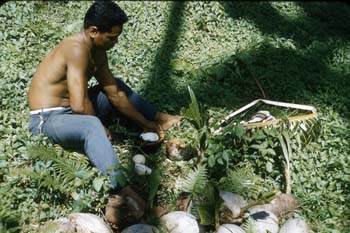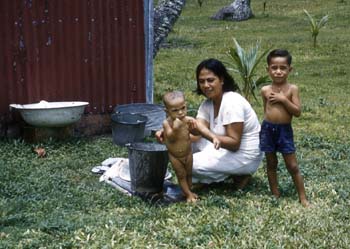The photo essay below is the fifth installment of a personal account of my two years in Fiji and Rotuma from October 1959 through August 1961. The main purpose of this project is to provide photographic images that might be of interest to contemporary Rotumans.
I have forgotten the names of some of the people who appear in the photos and would welcome your help in identifying them. Information identifying people should be sent to <ahoward@hawaii.edu> Please identify the photos by the numbers (#) in the captions.
Episode 5: Garue (Work)
I spent much of my time during the year trying to learn as much as I could about life on the island -- not just about the customs and ceremonies, what people believed, and stuff like that, but about how people lived from day-to-day, how they spent their time. Not surprisingly, I found that people spent most of their time working. The men usually went to their plantations early in the morning, often before the sun came up, and spent hours planting, weeding, harvesting taro, yams, bananas, etc., and cutting copra. They also spent a good deal of time preparing food and cooking it in a koua (earth oven). To be a good provider for one's family was the hallmark of a good man. Men also constructed houses and built canoes.
 |
 |
#170 Aliti cutting grass with cane knife |
#144 Ieni Feskatoa grating coconuts |
Women spent their time keeping their houses and compounds clean and tidy, taking care of children, washing clothes, cooking, and making mats (the wealth of Rotuma in the old days). Both men and women went fishing to supplement the food supply. I was surprised to see so many old women who were stooped over, but when I saw how much time they spent bent over to cut grass and weeds I understood.
 |
 |
#208 Bringing food from the bush |
#166 Woman weaving basket |
There weren't very many cash-paying jobs on the island at the time. Aside from a handful of government jobs, a few people were employed by the firms, Morris Hedstrom and Burns Philp. The Rotuman Cooperative Association was doing really well and paid wages to a few people as well, but most people had to rely on cutting copra to earn money.
 |
 |
#241 Jione Pagkale making a canoe |
#234Woman washing clothes |
 |
 |
#cop01 Amai Sakimi cutting copra |
#a&c08 Woman bathing child |